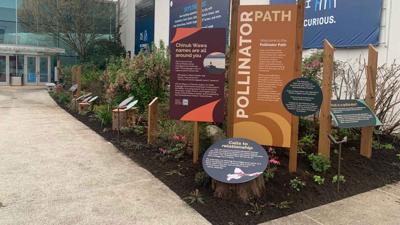Growing up, there was no greater place to be than the bright white courtyard of the Pacific Science Center. In fact, it’s such an intensely emotional childhood staple for my family that when I think of learning as a child, I almost always reflect on an experience I had underneath those arches.
While today I really only find myself visiting to see movies like “Oppenheimer” on their IMAX screen, I relish the opportunity to reignite my curiosity for the wonder of science through exhibits like Pollinator Path.
Designed in partnership with Owen Oliver, UW alum and creator of the Indigenous Walking Tour, Pollinator Path is a new outdoor exhibit that encourages visitors to develop an understanding of the mutualistic and cyclical relationship between plants, pollinators, animals, and humans.
“It was my idea to bring this notion of how we talk about nonhuman kin, such as plants and animals, into a relationship with us,” Oliver said. “Pollinators are so important, not just for us to bring food on our table and make the world go around, but also they're important to each other. It's a mutualistic relationship that we call reciprocity, how we help each other out.”
The exhibit is a short, vegetated walking path that highlights native plants and animals. Signage in the exhibit presents these species and their connections to each other, while an audio recording of their English and Chinuk Wawa pronunciations plays over speakers throughout the path.
“[Chinuk Wawa is] a trading language of the Pacific Northwest that was spoken in Seattle a lot,” Oliver said. “I wanted to bring in the diversity of Indigenous languages, and bring in some art, just to make people feel a renewed connection to plants and animals. Taking away the person as the observer, but almost as the active participant.”
The use of Indigenous language reflects the cultural and geographical inheritance of the city of Seattle and its surrounding nature, allowing patrons to rediscover connections between their indigenous neighbors and histories. The exhibit aims to highlight the relationship between western science and place-based, Indigenous knowledge systems.
Its online guide asks users and visitors to reflect on the question: “How can you be an active steward?” and to answer the call by developing a personal relationship with plants, pollinators, and acknowledging the land that surrounds us.
“The most important thing is just understanding that getting a larger holistic view of a place, let's say in Seattle, benefits everybody,” Oliver said. “Everyone benefits from more stories that directly connect either to environmental justice, to just new ways of how to operate, new ways of taking an appreciation of nature and those relationships.”
Indigenous ways of knowing are sometimes seen to be contrary to STEM learning, but Oliver and many instructors across the country are continually developing new initiatives and strategies that strive to dismantle the social constructs that divide the two knowledge systems.
For visitors at the Pacific Science Center, this can mean cultivating an environment of inclusion and openness, encouraging young people and their families to take part in knowledge creation.
“How do we tell these stories in a way that people can feel the agency to tell them as well, to transfer that knowledge,” Oliver said. “There's a lot of stories that we can't share because of privacy, and we don't want to. But for these things, it's so important to invite people and to welcome people in, and to just understand this information in just small little snippets.”
At UW, students can take part in a similar reflection through participating in initiatives like Oliver's own Indigenous Walking Tour or by enrolling in classes that encourage you to reflect on learning and history in diverse ways, like through the American Indian studies department.
“Understanding these stories that have been here since time immemorial is important for how we view science in the future,” Oliver said. “It gives us a precedent of how these lands have been operated far longer than how history sees it.”
Reach writer Laura Schladetzky at arts@dailyuw.com. X: @LSchladetzky
Like what you’re reading? Support high-quality student journalism by donating here.





(0) comments
Welcome to the discussion.
Log In
Keep it Clean. Please avoid obscene, vulgar, lewd, racist or sexually-oriented language.
PLEASE TURN OFF YOUR CAPS LOCK.
Don't Threaten. Threats of harming another person will not be tolerated.
Be Truthful. Don't knowingly lie about anyone or anything.
Be Nice. No racism, sexism or any sort of -ism that is degrading to another person.
Be Proactive. Use the 'Report' link on each comment to let us know of abusive posts.
Share with Us. We'd love to hear eyewitness accounts, the history behind an article.